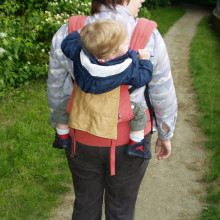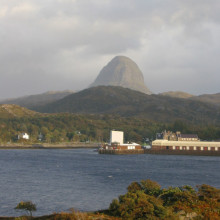In this NewsFlash, we discover that happiness is in the here and now, as thinking about something other than the task at hand seems to lead to low mood. We find out why children tire so quickly when walking, and explore evidence in Scottish rocks that Earth became oxygenated 400,000 years earlier than we thought. Plus, the elegant physics of a lapping cat!
In this episode

00:27 - Happiness is Here and Now
Happiness is Here and Now
When are you at your happiest? Research published this week shows that we are most happy when we're concentrating on the job at hand, rather than allowing our minds to wander. But, oddly, people seem to spend almost half of their waking hours thinking about something other than what they're currently doing.
 Matthew Killingsworth and Daniel Gilbert, from Harvard University, developed a free application for smartphone users that contacted it's users at random intervals to ascertain their happiness, what they were doing and, importantly, what they were thinking about. They asked if they were thinking about what they were currently doing or, if not, was it something pleasant, neutral or unpleasant.
Matthew Killingsworth and Daniel Gilbert, from Harvard University, developed a free application for smartphone users that contacted it's users at random intervals to ascertain their happiness, what they were doing and, importantly, what they were thinking about. They asked if they were thinking about what they were currently doing or, if not, was it something pleasant, neutral or unpleasant.
It's thought that our ability to contemplate events in the past, as well as possible future events, is a vital part of the human condition. It helps us to learn, reason and make plans, but this study, published in the journal Science this week, set out to see how it affects our happiness.
Reports of mind-wandering, or "stimulus independent thought" were strikingly common in their results. For 21 of the 22 different categories of activity, people reported that their minds were wandering no less than 30% of the time. The only activity where people didn't report this much mind wandering was when making love. Contrary to what you might expect, the activity in hand didn't actually affect how pleasant the daydreaming was.
But how does this relate to happiness? By performing a multilevel regression analysis, which is a statistical analysis that can show causal relationships in sets of data, the researchers were able to show that people were less happy when allowing their minds to wander. In fact, even thinking pleasant thoughts was no more likely to make you happy than staying "in the moment".
So it seems that there may be some truth in the philosophical and religious teachings that tell us happiness is attained by "concentrating on the moment" but, still, a wandering mind is a useful one. The authors argue that "the ability to think about what is not happening is a cognitive achievement that comes at an emotional cost".

03:30 - Why kids get tired just walking around
Why kids get tired just walking around
As any parents, aunties or uncles know full well, kids get much more tired out simply walking around than adults do, and now scientists have taken a step closer to understanding why this is. It's not just that they run up and down more, or that we get more efficient at walking as we grow taller, but in fact it's all about having longer legs.
Publishing in the Journal of Experimental Biology, Peter Weyand from Southern Methodist University in the US led a team of researchers who investigated the metabolism and gait of a group of walking volunteers ranging from 5 to 32 years old who were between 3 and over 6 feet tall.
 It's already known that across all sorts of different animals, those with smaller bodies use more energy per unit of mass than larger animals. But this doesn't actually give us a full answer as to why little people use up more energy walking around - it's more than just a factor of their different metabolic rates.
It's already known that across all sorts of different animals, those with smaller bodies use more energy per unit of mass than larger animals. But this doesn't actually give us a full answer as to why little people use up more energy walking around - it's more than just a factor of their different metabolic rates.
Weyand's team monitored the energy used up by each volunteer as they walked on a treadmill at different speeds ranging from half to 1.9 meters per second, and discovered that smaller people use the same amount of energy per stride as taller folk - but with littler legs, they have to take more strides to cover the same ground, using up more energy in the process.
So essentially, if you scaled up a 3 foot, 5 year old to be the same size as a 6 foot adult, they would walk exactly the same way revealing that grown ups don't have a different, more economic way of walking they just benefit from having longer legs.
Based on their findings the research team have come up with an equation that calculates the energetic cost of walking, which will have lots of useful applications including for pedometers and treadmills. By inputting not just your weight, as many machines currently do, but also your height, we now have a much more accurate way of working out how many calories you'll burn over a certain distance.
So this is great - because it means next time I'm at the gym on a treadmill running next to an elegant tall athlete, I have a genuine scientific excuse for finding it more hard work, because just like toddlers, us vertically-challenged folk use more energy just getting around.

06:34 - Earth's Oxygenation came Earlier than Expected
Earth's Oxygenation came Earlier than Expected
Professor John Parnell, University of Aberdeen
Previously, we have believed that the Earth's atmosphere turned oxygen-rich about 800 million years ago and this ushered then the era that made complex life like us possible. But now, new research from Scotland shows that we might have got it wrong. And in fact, oxygen levels increased much, much earlier. Speaking to Chris Smith, University of Aberdeen Geologist, Professor John Parnell...
 John - We're examining a key stage in the evolution of life on Earth. The evidence relates to a particular group of microbes which have been very successful and very widespread. Today, they colonise everywhere from freezing glaciers down to hot smokers in the deep ocean. They rely on reducing sulphate, so these are what are known as sulphate-reducing bacteria or sulphate-reducing microbes. But they made an important advance by getting energy in a more efficient way which involved making use of oxygen in the environment. So it's as a marker for increasing oxygen in the atmosphere that they are really important in this context.
John - We're examining a key stage in the evolution of life on Earth. The evidence relates to a particular group of microbes which have been very successful and very widespread. Today, they colonise everywhere from freezing glaciers down to hot smokers in the deep ocean. They rely on reducing sulphate, so these are what are known as sulphate-reducing bacteria or sulphate-reducing microbes. But they made an important advance by getting energy in a more efficient way which involved making use of oxygen in the environment. So it's as a marker for increasing oxygen in the atmosphere that they are really important in this context.
Chris - So we can use them as a proxy measure for when oxygen in the Earth's atmosphere in general increased and then that in turn enabled more complicated things like us to come along.
John - That's right. It's important because as oxygen increased in the atmosphere and started to penetrate into the subsurface, this opened a way to complex life including animals, and for that life to burrow down beneath the surface. So we're looking not just at an evolution of life, but an evolution of habitat as well, and an evolution of behaviour because of course, as life went beneath the surface, it could then escape predators, et cetera.
Chris - Can you put some timing on this for us? When exactly looking back in geological history are we talking about?
John - Well, it had been thought that this evolution to make use of oxygen occurred about 800 million years ago. We now have evidence from our rocks in Scotland that this occurred at least 400 million years before that. So we're substantially putting back the boundary to at least 1.2 billion years old. The oldest evidence that we have comes from near Lochinver in Sutherlandshire on the West Coast of Scotland. That's at 1.2 billion. And then we have continuing evidence from about 1 billion years old in the Gairloch district which is also on the West Coast of Scotland.
Chris - And when you say you've got this evidence, what are you looking for and what are you actually finding?
 John - The evidence doesn't come from conventional fossils. It comes from what we call chemical fossils that is distinctive chemical signatures that were left behind by the microbes. And in this case, it relates to a detailed analysis of the sulphur that the microbes were using to get energy. That sulphur now occurs in the mineral, iron pyrite and that's what we have sampled and analysed, and we've done that in a couple of different ways. We have done some chemical extractions from the pyrite. We've also used a laser technique on the pyrite and in both cases, we extract the sulphur out and then analyse its isotopic composition. And it's the details of that isotopic data that tells us that the microbes must've been using oxygen and therefore, that enough oxygen was available to them.
John - The evidence doesn't come from conventional fossils. It comes from what we call chemical fossils that is distinctive chemical signatures that were left behind by the microbes. And in this case, it relates to a detailed analysis of the sulphur that the microbes were using to get energy. That sulphur now occurs in the mineral, iron pyrite and that's what we have sampled and analysed, and we've done that in a couple of different ways. We have done some chemical extractions from the pyrite. We've also used a laser technique on the pyrite and in both cases, we extract the sulphur out and then analyse its isotopic composition. And it's the details of that isotopic data that tells us that the microbes must've been using oxygen and therefore, that enough oxygen was available to them.
Chris - So why did you undertake this study because everyone was pretty sure that about 800 million years ago, that's when things suddenly began to change? So why did you then go looking and say, "Well, is that really the date?"
John - Well, I mean, most of the rocks from this age are from the ocean, but we were aware that we had rocks back at 1.2 billion which had been laid down in a large lake. So this is effectively a terrestrial environment and that means that any microbes that might've been inhabiting that environment were much more in tune with what was going on in the atmosphere. So if there was going to be anywhere where we might find this earlier signature, it was going to be in terrestrial rocks like the ones we had. So that was a good reason to go looking there and it happens that these rocks up in Northwest Scotland are particularly well preserved for their age. So, there was a good reason to go searching there.
Chris - And I guess now, what you're going to have to do is to independently confirm or corroborate this perhaps by looking at other rocks from other bits of the world of an equivalent age, and see if you can see the same signature written there.
John - Well in a way, we actually have already corroborated this because we first of all looked at the rocks at 1.2 billion - these were the ones near Lochinver and then we looked at a younger set of rocks. I mean, quite a different set of rocks of 1 billion years old. These were the ones near Gairloch and they showed us the continuation of the same signature. So we've shown that this is not just an isolated event. We actually have a continuing story.
Chris - And what are the implications of it?
John - Well I mean, the implications are that we are pushing back the time at which there was enough oxygen in the atmosphere to support the evolution of complex life. Now it may well be that there were some other event which eventually kicked off the evolution of animals. But what we've shown is, that there was enough oxygen around so that the atmosphere was not a barrier to that evolution.
Ben - Which is a good thing at least where we're concerned. That was Aberdeen University's John Parnell, talking with Chris Smith.

12:11 - Lap Cats Lap Fast
Lap Cats Lap Fast
We've been living alongside cats for thousands of years but it's taken until now to fully understand how they perform one of the most basic of tasks - drinking.
All cats, from the mightiest wild tiger to the laziest fat lapcat, drink with a very subtle action that takes advantage of a balance between gravity and inertia; the tendency for something to keep moving in the same direction unless acted upon by an external force.
 Back in the 1940s, MIT engineer Doc Edgerton filmed a domestic cat lapping at milk. We've known since then that they form a distinctive shape with their tongues, curling the tip of the tongue backwards so the top, or dorsal, side of the tongue is the first to hit the water.
Back in the 1940s, MIT engineer Doc Edgerton filmed a domestic cat lapping at milk. We've known since then that they form a distinctive shape with their tongues, curling the tip of the tongue backwards so the top, or dorsal, side of the tongue is the first to hit the water.
Writing in the journal Science this week another MIT researcher, Roman Stocker, and his colleagues have used high-speed video footage of domestic cats including Stocker's own pet, Cutta Cutta, along with a range of big cats in local zoos. Using data from these observations they were then able to build a robotic version of a cat's tongue to really get to grips with the mechanisms involved.
When the tongue comes into contact with the liquid some of the liquid will adhere to the surface of the tongue. As the tongue is retracted, it pulls a column of liquid along behind it. Here's where the elegant physics comes in to play. The column is pulled up by inertia and simultaneously pulled back down by gravity.
Interestingly, surface tension and viscosity seem to play little or no role, and as the tip of the tongue has none of the distinctive hair-like projections that make cats' tongues so rough, these also play no part in the physics of lapping. Also, it seems that cats drink in a very different way to dogs, who merely use their tongues to scoop up liquid.
As well as helping us to understand how cats maintain their refined image, even when lapping rainwater from puddles, understanding these mechanisms will inform biomechanical models and help us to design better "soft robots".










Comments
Add a comment